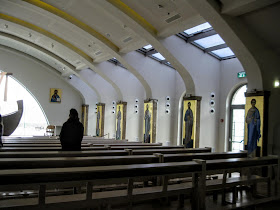Step into The Women's Atrium and be moved.
Some Franciscans were visiting Duc In Altum at Magdala Center, too.
Smartphone + biblical sandals for the friars of our time.
After Jesus "drove out the demons" from Maria Magdalene, she became his faithful disciple.
And Magdala is the town of her birth. So of course there is a pillar for her.
The other columns are for Susanna & Joanna (Luke 8:3), Martha & Mary (Luke 10:38), Salome (Mark 15), Simon Peter's mother-in-law (Matthew 8:15), Maria Cleophas (John 19:25), and "many other women" (Aliae Multae) who supported Jesus (Mark 15:41).
But the coolest thing here is that one pillar has been left empty, waiting for YOUR name!
As the brochure explains,
"One unmarked pillar stands for women of all time who love God and live by faith. Each woman can spiritually inscribe her name as a poignant reminder of her role in the history of humanity."
The baptismal font stands solidly in the middle of the atrium.
The mosaic on this side is called Descending as a Dove, recalling how the Holy Spirit descended while Jesus was being baptized in the Jordan River.
Water flows from the center, making meditative ripples.
Quoting again,
"The cupola reflects the sky, [seven] stars and sun's rays with a piece of an image from Our Lady of Guadalupe, the Mother of Jesus, found on the 'tilma' of a native Mexican in 1531. Her folded hands signify the importance of women who accompany Jesus in the mission of extending the kingdom through prayer."
(More about the tilma here.)
The golden Latin phrase encircling the image on the cupola echoes an idea from the letter on the Dignity of Women (#31) by Pope John Paul II. It can be translated:
In this holy place, 'the Church gives thanks to the Most Holy Trinity for the mystery of woman, and for every woman, for her eternal dignity and for the wonders God has worked in and through her in the history of humanity.'And one last message from the Magdala brochure (check my photos above to see what is referred to):
Magdala is a crossroad of Jewish and Christian history. To reflect this, the walls have been painted with the same colors found in frescoes of the 1st century synagogue [i.e. discovered on their grounds and which I'll post about soon].In case you missed my previous two posts, you can find my photos of the exterior of this new spiritual center here and about the unique Boat Chapel here.
The mosaic on the floor of the atrium imitates the meander style pattern found in the synagogue. Upon the floor mosaic stand 8 columns replicating a Byzantine style church. The columns are inscribed with the names of New Testament women.
The combination of Jewish and Christian artistic elements in the Women's atrium symbolizes the connection between the Judaic and Christian heritages. For Christians, it is a reminder of the continuity between the Old and New Testaments, and the Jewish roots of Christianity.
More about Duc In Altum's side chapels and the downstairs Encounter Chapel and about the antiquities in coming posts.
Lots more about the work in progress at their website, http://www.magdala.org/about/core-culture/ .
.
(Linking to inSPIRED Sunday.)
.













































